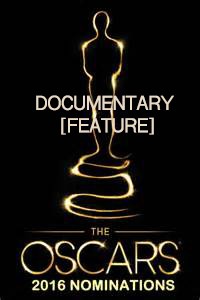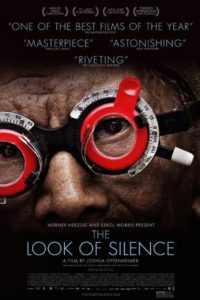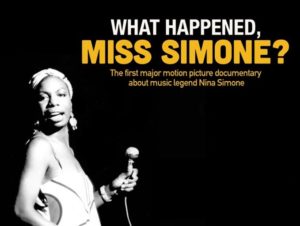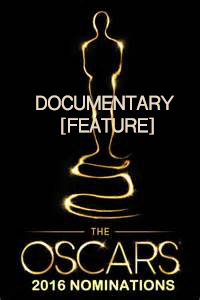 I’ve seen all of the nominees this year, thanks to attending the AFI DOCS and Full Frame festivals and Netflix. If you’re filling out your Oscar ballot, here are my somewhat edited down reviews of the nominees. It was a great year for docs, though I think they missed a few, but I’m sure they had a hard time whittling down the field. And the nominees are…
I’ve seen all of the nominees this year, thanks to attending the AFI DOCS and Full Frame festivals and Netflix. If you’re filling out your Oscar ballot, here are my somewhat edited down reviews of the nominees. It was a great year for docs, though I think they missed a few, but I’m sure they had a hard time whittling down the field. And the nominees are…
Trailers for all the films are at the end of this post.
 The Look of Silence was a film I’d been looking forward to. It is a companion piece to the most disturbing documentary of the last few decades, The Act of Killing, which was also nominated for an Oscar. Where that film was about the 1960s Indonesian genocide from the point of view of the unrepentant perpetrators, this much quieter film tells the story from the perspective of the younger brother of one of the victims, as he tries to find out how the murderers live with what they did. He is an optometrist and travels around his community fitting many older men for glasses, using the occasion to ask them questions about their role in the killings. A few of them get angry with him for bringing it up, and some of their children claim to have never heard about their parents’ role in the mass killings. But most of the older people remember his brother and his death, and they freely share their memories of their roles in it, though for them it was just something that happened back then, no more.
The Look of Silence was a film I’d been looking forward to. It is a companion piece to the most disturbing documentary of the last few decades, The Act of Killing, which was also nominated for an Oscar. Where that film was about the 1960s Indonesian genocide from the point of view of the unrepentant perpetrators, this much quieter film tells the story from the perspective of the younger brother of one of the victims, as he tries to find out how the murderers live with what they did. He is an optometrist and travels around his community fitting many older men for glasses, using the occasion to ask them questions about their role in the killings. A few of them get angry with him for bringing it up, and some of their children claim to have never heard about their parents’ role in the mass killings. But most of the older people remember his brother and his death, and they freely share their memories of their roles in it, though for them it was just something that happened back then, no more.
The men who massacred a million of their countrymen are still in charge of the country, as well as the official narrative of what happened, as we see in a scene where the younger brother’s son is (mis)taught history in school. The audience is also present as a few of the killers return to the site where the brother was brutally murdered, as they narrate and recreate his death. You’d think they were talking about a fishing expedition the way they talk about it with absolutely no remorse. The Look of Silence is really not a stand-alone film. It is the counterpoint to the earlier film (though both were apparently shot at the same time.) The first was full of drama and bravado, and this is the flip-side with silences and pain. Together they present a fuller picture of the still unreconciled rift in the Indonesian community. Well worth seeing. Available as a rental from Netflix.
 Amy is the utterly tragic tale of singer Amy Winehouse, who was so full of talent and entirely incapable of dealing with the fame that came with her gifts. It is yet another story of addiction and greed and media frenzy killing a young performer. This devastating documentary is like the proverbial train wreck. You know what is going to happen, and you can’t stop it, but you can’t look away.
Amy is the utterly tragic tale of singer Amy Winehouse, who was so full of talent and entirely incapable of dealing with the fame that came with her gifts. It is yet another story of addiction and greed and media frenzy killing a young performer. This devastating documentary is like the proverbial train wreck. You know what is going to happen, and you can’t stop it, but you can’t look away.
The filmmakers were very fortunate that Amy and her friends and family LOVED to document her all the time, and that they were delusional enough to think that they would come off well, given their roles in her life and death. They handed over video of all aspects of her short life, from her teenage days being goofy and playing around with her friends, to meeting the man who would be her manager and introduce her to the music biz, to her destructive/passionate relationship with (husband) Blake Fielder-Civil who encouraged her drug use, and even her fame-whore of a father who in fact did keep her from going to rehab. What is so heartbreaking is that you get to watch her sing A LOT, pouring out her heart and soul in her songs, and the filmmaker was smart to subtitle them so you see exactly what she was going through as she sang. Tony Bennett, who appears in the film as they record a song for his Duets II album, put her in the same category as Ella Fitzgerald or Billy Holliday, one of the great jazz singers, and it is very telling when he says that jazz singers prefer a small audience and she agrees. Amy is one of those movies that makes you so sad for what might have been. Now streaming on Amazon Prime.
 What Happened, Miss Simone? is another beautiful film about an amazing singer. I’ve always loved Nina Simone’s music, but I found out so much more about her tragic life though the film. She was born very close to where I live in the mountains of North Carolina, in the days of segregation, but her musical abilities set her apart. She had a distinctive voice and rose to be one of the most famous singers of her day. But her choice to write and perform songs of protest during the Civil Rights era derailed her career. And living with undiagnosed bipolar disorder nearly wrecked her life.
What Happened, Miss Simone? is another beautiful film about an amazing singer. I’ve always loved Nina Simone’s music, but I found out so much more about her tragic life though the film. She was born very close to where I live in the mountains of North Carolina, in the days of segregation, but her musical abilities set her apart. She had a distinctive voice and rose to be one of the most famous singers of her day. But her choice to write and perform songs of protest during the Civil Rights era derailed her career. And living with undiagnosed bipolar disorder nearly wrecked her life.
What Happened, Miss Simone? explores her very dramatic off-stage existence. She was in an abusive relationship with her husband/manager, had a difficult time with her daughter, made friends with some of the biggest names in the Civil Rights Movement, rose to amazing heights and nearly ended up in poverty. But through it, she remained true to herself and her ideals, and was one of the most amazing performers ever. If you’ve loved her music as I have, this film with make you appreciate her on a whole other level. See it now on Netflix!
 The bulk of Winter on Fire: Ukraine’s Fight for Freedom was shot over 93 days in 2013 and 2014 in the central square of Kiev called the Maidan Nezalezhnosti. Thousands of students came to the square to protest Ukrainian President Yanukovych’s choice not to join the EU. But what began as a peaceful protest quickly became a violent revolution and ultimately led to the president sneaking away in the night. The film is very much like last year’s The Square, in that it puts you right in the center of the action with the people fighting and dying around you. Their courage to stand up for democracy is truly inspiring.
The bulk of Winter on Fire: Ukraine’s Fight for Freedom was shot over 93 days in 2013 and 2014 in the central square of Kiev called the Maidan Nezalezhnosti. Thousands of students came to the square to protest Ukrainian President Yanukovych’s choice not to join the EU. But what began as a peaceful protest quickly became a violent revolution and ultimately led to the president sneaking away in the night. The film is very much like last year’s The Square, in that it puts you right in the center of the action with the people fighting and dying around you. Their courage to stand up for democracy is truly inspiring.
Though students were those who got the movement rolling, they were soon joined by all strata of Ukrainian society — clergy of every religion, the old, celebrities, doctors, various military groups, and lots of people from outside the city. They were up against not only the brutal special police forces called the Berkut, but also a group of sadistic criminal thugs known as Titushky. But when the people did not back down, the police switched out rubber bullets for live ammo. There is one shot in the film that is as devastating as anything I’ve ever seen. A man goes out into the melee to help one of the wounded and is shot dead. You see him hit and you see the life drain out of him. Clad in black helmets with riot gear, the police personified evil. They burned hospitals and destroyed their medicine. They beat unarmed people to death. As a testament to the young people who organized nearly a million people and fought back the repressive powers in their country, it is really quite a beautiful film. I highly recommend it. It is available to stream on Netflix.
 Cartel Land is my least favorite among this bunch. It looks at two groups of vigilantes, each dealing in their own way with the effects of the Mexican drug cartels. One is on the US side and one, the more interesting one, is deep inside Mexico. It would have been a much better film had the director focused solely on the Mexican story. The American part is all about a bunch of gun-toting macho men who have appointed themselves the guardians of a strip of Arizona-Mexico border. But in reality, rather than dealing with drug smugglers they’re mostly using their high tech gear to stop “illegals.”
Cartel Land is my least favorite among this bunch. It looks at two groups of vigilantes, each dealing in their own way with the effects of the Mexican drug cartels. One is on the US side and one, the more interesting one, is deep inside Mexico. It would have been a much better film had the director focused solely on the Mexican story. The American part is all about a bunch of gun-toting macho men who have appointed themselves the guardians of a strip of Arizona-Mexico border. But in reality, rather than dealing with drug smugglers they’re mostly using their high tech gear to stop “illegals.”
The gripping story in this doc is about the vigilantes way south of the border in the Mexican state of Michoacán, headed by a charismatic doctor named Jose Manuel Mireles. With violence against ordinary citizens by a cartel called The Knights Templar out of control, as grizzly murders, kidnappings, and rapes become the norm, and the Mexican government doesn’t lift a finger to help, Mireles organizes the citizens to create a group known as Autodefensas and routs the cartel from town after town. The film is gritty and violent as the camera is embedded in the fighting. And you’re rooting for them, but following a series of successes, they begin to act very much like the cartels, just as Mireles warned them when they began their movement. I wish the film had been entirely about this group, because whenever they cut back to the US, as if these two groups have something in common, the film flags. The moral of the story is that the cycle of violence is so incredibly hard to break because power corrupts. I’d say see the film, but just for the Mexican part. It is powerful. Cartel Land is currently streaming on Netflix.
The Look of Silence
Amy
What Happened, Miss Simone?
Winter On Fire
Cartel Land

